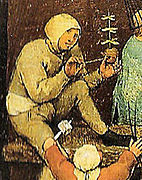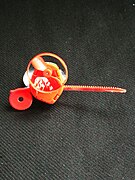Pinwheel (children's toys)
A windmill is a simple children's toy in which a rotor made of paper or another light material such as leaves, plywood or plastic is attached to a rod in such a way that it can be easily set in motion by the wind or by blowing on it. It can be made by yourself with simple materials without much effort and is therefore one of the toys that were probably known even before the commercial toy manufacture. The exact date of its creation is not known.
Playing with the wind turbine enables the sensual experience of the transformation of a horizontal movement into a circular movement. It makes something invisible in itself (wind) perceivable in its effect by hitting the toy. Even a small child can through the established outdoor wind turbine the different speed rotation of the wind turbine by the stronger or weaker wind watch or see how the wind turbine at different speeds in the wind moves when the stroller is fastened. The slightly older child can experience the interplay between their own actions and their respective different effects by blowing their own breath or running with the wind turbine.
Forms, variants
In the Japanese art of folding origami , the pinwheel is known in a slightly different folding technique and is one of the basic forms from which many other figures can be folded.
A special form of the wind turbine as a children's game can be found in the painting The Children's Games by the Dutch painter Pieter Bruegel the Elder . Wind turbines with a rotating coil are still known today, e.g. B. there was such a thing as the content of a surprise ice cream .
In the folk art of the toy makers in Seiffen in the Ore Mountains , a plug-in wind turbine was made in the Seiffener Miniatures series , which, when not yet assembled, had space in a matchbox.
On March 16, 2000, Deutsche Post issued a postage stamp with a moving wind turbine with colorful wings in its Post series . The design came from the graphic artist Peter Steiner .
Chinese wind turbine
Another form of windmill as a toy for children and adults can be found in China . A multitude of small, mostly colorful sails run like a carousel on a vertical rotor axis in a circle. This shape is based on the construction of the Chinese windmills , which were used to irrigate fields and extract salt . Historically, the basic structure of the toy wind turbines consisted of millet stalks cut to size and a small round drum made of clay and paper, which produced a drumming sound when turned.
This form has a tradition in China that is believed to be at least a thousand years old. Images were found on a Song Dynasty painting and clothes of the Ming Dynasty Emperor . As wheels of fortune, they are traditionally sold in the temple markets during the Chinese New Year celebrations and attached to doors and windows to attract good fortune for the coming year.
photos
Seiffen miniature wind turbine
Windmill with rotating coil of The Kids of Bruegel the Elder
Individual evidence
- ↑ Origami folding instructions wind turbine. Retrieved October 27, 2017 .
- ↑ Match box goods in Auerbach, K. and W. Neumann: An Erzgebirge toy pattern book told. Toys, sample sheets and catalogs from 2 centuries. Series of publications, issue 8, Seiffen 1993 . Retrieved April 28, 2018.
- ↑ Chinese wind turbines - More than just a toy . CRI online from September 23, 2011 . Retrieved November 19, 2017.






